Exploring the UAE's Architectural Marvels: Tallest Structures

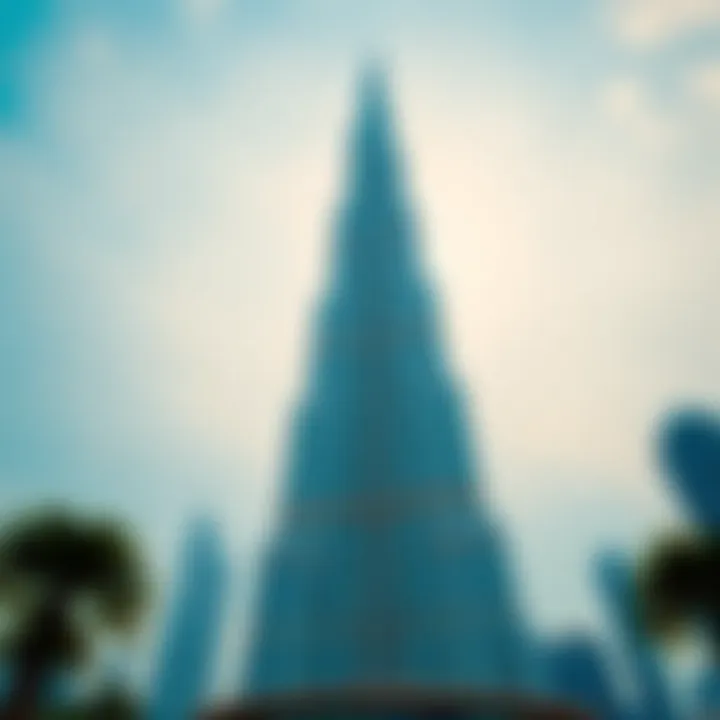
Market Overview
The architectural landscape of the UAE has undergone a remarkable transformation over the past few decades. With impressive skyscrapers defining the skyline, this region has not only become a tourist hotspot but also a focal point for real estate investment trends. Understanding these trends is essential for investors, agents, and homebuyers alike.
Current Trends
As of late 2023, the UAE's real estate market shows signs of resilience, spurred by an influx of expatriates and a recovering global economy. Recent data indicates that areas surrounding iconic structures like the Burj Khalifa and the Abu Dhabi Etihad Towers are witnessing a surge in demand. This demand is largely driven by the desire for luxury living spaces that blend comfort with opulence.
Homebuyers are increasingly leaning towards eco-friendly designs and sustainable features. This shift reflects a broader global trend where individuals prioritize energy-efficient living. Architectural designs now encompass advanced technology to ensure energy conservation, like solar panels and smart home systems.
The market's momentum is further bolstered by government initiatives aimed at easing regulations and streamlining processes for foreign investors. For instance, the introduction of long-term visas for expatriates and the expansion of affordable housing schemes are pulling more buyers to the market.
Forecast and Predictions
Looking ahead, industry experts foresee a sustained growth trajectory for the UAE's real estate sector. Reports predict that by 2025, the market could see a 10-15% increase in property prices, particularly within urban centers. Investors are advised to keep their eyes peeled for emerging sectors such as wellness-focused spaces, where buyers are seeking homes that offer both comfort and healthy living environments.
There's a buzz about projects that merge residential and commercial properties, designed to create multifunctional spaces that enhance urban living experience. This evolution represents a shift from traditional real estate investments, indicating a more integrated approach where living, working, and leisure spaces intertwine.
"The skyscrapers tell a story of ambition, innovation, and resilience. Understanding their impact on the real estate landscape is crucial for any investor."
Investment Opportunities
In an environment brimming with potential, investment opportunities abound. Both residential and commercial properties are appealing to a broad range of investors, yet they carry their unique attractiveness and challenges.
Residential Properties
Investing in residential properties in the UAE offers a gateway into a market that is both lucrative and diverse. Developers are crafting homes that cater to varied lifestyles, from luxury penthouses in Dubai Marina to more modest family units in suburban areas. Properties near significant landmarks, such as workspaces and entertainment zones, often see quicker appreciation.
Here are some highlights to consider:
- Burgeoning Districts: Areas like Dubai Creek Harbour and Al Reem Island in Abu Dhabi are gaining popularity due to planned community features and proximity to urban amenities.
- Luxury Real Estate: High-net-worth individuals are increasingly investing in branded residences that combine exclusivity with world-class service.
- Rental Yields: Properties in key areas show rental yields ranging from 6% to 10%, making them attractive for those considering buy-to-let options.
Commercial Ventures
Commercial real estate is a cornerstone of the UAE's economy. As businesses grow and evolve, the demand for office spaces, retail, and logistics facilities continues to rise. Notably, the appeal of mixed-use developments enables investors to enjoy a diversified income stream.
Consider these points:
- E-commerce Surge: With the digital marketplace expanding, logistics and warehousing spaces are becoming highly sought after. Properties close to major transport hubs are well-positioned.
- Flexible Workspaces: Coworking spaces are on the rise due to the increase in remote and flexible working trends. Investing in such properties can yield positive returns as businesses adapt.
Preamble to the UAE's Architectural Landscape
The architecture of the UAE represents a fascinating juxtaposition of tradition and modernity. The skyline, particularly in cities like Dubai and Abu Dhabi, is hardly rivaled anywhere else in the world. In a mere few decades, the nation has transformed from a desert landscape into a hub of innovation, boasting some of the tallest and most technologically advanced buildings. This rapid evolution marks a significant shift in urban living and investment potential, drawing attention from global investors and architecture enthusiasts alike.
By exploring this architectural landscape, we can better appreciate the intricate balance between aesthetic appeal, engineering prowess, and the socio-economic factors that contribute to such monumental structures. The importance of this study extends beyond mere admiration; it anchors our understanding of how these buildings shape urban life and influence the real estate market.
Consider the impact of these skyscrapers: they are not just functional spaces—they are symbols of the UAE's ambitions and economic aspirations. Aurora-type structures often evoke a sense of progress and innovation that resonates with citizens and expatriates alike. As the region seeks to diversify its economy beyond oil, these architectural giants are essential to attracting tourism and investment, reinforcing the idea that in modern urban landscapes, height often equates to opportunity.
Historical Overview
The story of UAE's architectural journey is as rich as its culture. Prior to the mid-20th century, the region was characterized by humble structures built from local materials, reflecting the lifestyle and environmental conditions of the time. Traditional buildings, often constructed for functionality, were simple and utilitarian. However, the discovery of oil in the 1950s marked a turning point, ushering in rapid economic growth and, consequently, architectural evolution.
As the nation opened its doors to foreign investments and expertise, the architectural landscape began transforming. The late 20th century witnessed a surge in construction projects. The Burj Al Arab, a hotel that epitomizes opulence, was among the first of high-profile constructions signaling a new era. Likewise, the grand designs of modern skyscrapers now evoke global attention. Today, the UAE is home to numerous wonders like the Burj Khalifa, which transcends cultural and architectural boundaries.
Importance of Skyscrapers in Urban Development
The emergence of skyscrapers in the UAE isn't just about climbing to heights; it's about redefining urban existence. These towering structures contribute significantly to urban development by:
- Maximizing Space Efficiency: In a geographical area that often faces land scarcity, skyscrapers allow for the vertical expansion of communities.
- Promoting Economic Activity: High-rise buildings often host commercial offices, retail spaces, and hospitality sectors all under one roof, encouraging business interactions and boosting local economies.
- Enhancing Connectivity: Skyscrapers frequently feature integrated transport systems, improving access for residents and visitors alike.
- Attracting Global Talent: Well-designed cities attract skilled workers and families, making the UAE a melting pot of cultures and creating a dynamic workforce.
"The landscape of a city is a reflection of its culture and aspirations. In the UAE, skyscrapers are more than just buildings — they are icons of our progress."
In essence, the integration of skyscrapers into the urban fabric is a cornerstone of the UAE's ongoing mission: to craft a thriving, diverse, and vibrant society that balances tradition with forward-thinking innovation.
Burj Khalifa: The Tallest Building in the World
The Burj Khalifa stands as an iconic symbol of the UAE's rapid growth and architectural ambition. Towering at an impressive height of 828 meters, it is not just the tallest building globally, but also a focal point for investors, tourists, and urban planners alike. In this section, we will dissect various elements that make the Burj Khalifa a standout masterpiece in the realm of architecture and engineering.
Design and Architectural Features
The design of the Burj Khalifa is steeped in cultural significance while showcasing innovation. Its form draws inspiration from traditional Islamic architecture, evident in the minaret-like shape and the three lobes of the building that resemble the Hymenocallis flower. A striking feature is the building's tapering silhouette, which minimizes wind forces at higher altitudes.
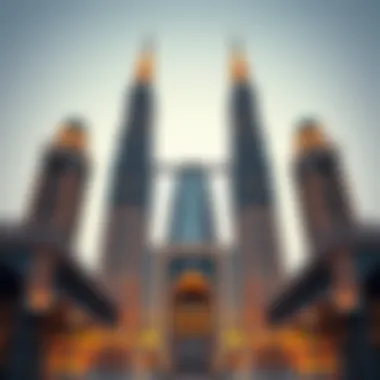
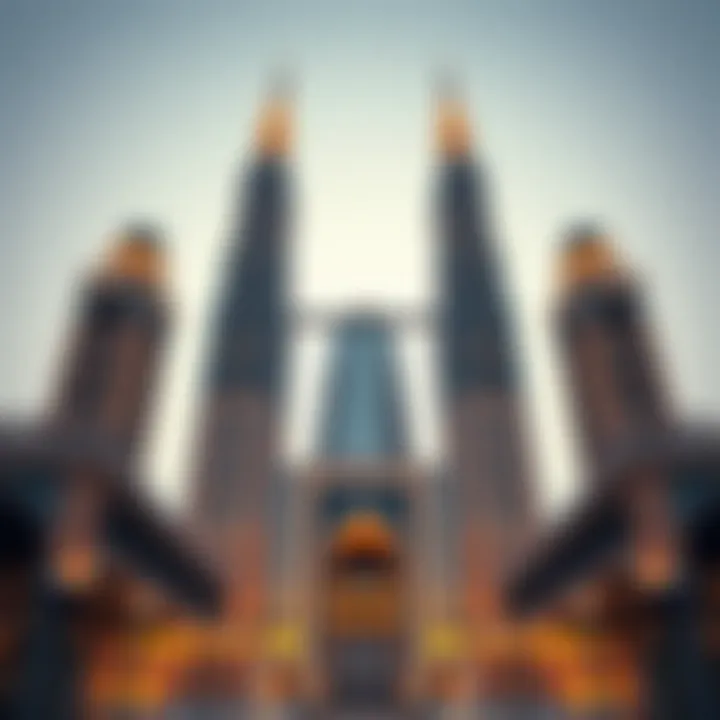
- Materials Used:
The structure employs high-performance concrete, featuring a unique mixture designed to withstand the harsh desert conditions. Over 103,000 square meters of glass and 14,000 tons of structural steel were used, providing not only durability but also an aesthetic experience. - Exterior Aesthetics:
Its stunning facade reflects sunlight, creating a dazzling effect during the day. At night, integrated lighting transforms it into a beacon of vibrancy, contributing to the dynamic skyline of Dubai.
Technological Innovations
The Burj Khalifa is a marvel of modern engineering, incorporating state-of-the-art technologies to enhance safety, functionality, and eco-friendliness.
- Elevator Systems:
Equipped with the world’s fastest elevators, the Burj Khalifa reaches speeds of up to 10 meters per second. The system is designed to be energy efficient, significantly reducing power consumption while ensuring a swift transit for occupants. - Climate Control:
The building utilizes a unique cooling system that is energy-efficient. This system significantly lowers the internal temperature, balancing comfort with cost-efficiency.
"The Burj Khalifa's design transcends mere aesthetics; it embodies engineering excellence, cultural values, and technological advancements."
Cultural and Economic Impact
Burj Khalifa has generated substantial cultural and economic waves, marking its presence far beyond its physical stature.
- Tourism Magnet:
As a must-visit landmark, it attracts millions of tourists each year. The observation decks offer breathtaking views, while the surrounding park adds to the experience, making it a desirable location for leisure activities. - Economic Catalyst:
The building has catalyzed substantial economic activity in Dubai, boosting the hospitality and real estate sectors. Areas surrounding Burj Khalifa have seen increased property values, making it a hotspot for real estate investors, particularly expatriates seeking a high-quality living experience. - Cultural Significance:
Beyond economics, it plays a role in defining the national identity of the UAE. Events like the New Year’s Eve fireworks and light shows have turned the Burj into a symbol of celebration for residents and visitors alike.
In summary, the Burj Khalifa is not merely a towering achievement in architecture; it represents the aspiration and vision of a global city determined to push boundaries. Such landmark structures are vital for attracting foreign investment and developing a thriving real estate market.
Abraj Al Bait Towers: Beyond the Height
When considering the skyline of Mecca, the Abraj Al Bait Towers stand tall as a testament to modern architectural feats and deep-rooted cultural significance. This particular complex does not merely add to the height of the city; it conveys a rich tapestry of history, architectural ingenuity, and spiritual importance that resonates with millions.
The Abraj Al Bait Towers, comprising several towers with the clock tower prominently towering above, serves as an important landmark not just for the city or the Kingdom of Saudi Arabia, but also for the world. With its mix of luxurious hospitality and function, it is a crucial player in catering to the millions who come to Mecca for pilgrimage.
Historical Context
The genesis of Abraj Al Bait can be traced back to a desire for modernization amid the impetus of growing pilgrim numbers. Initially, the site hosted an array of old buildings that, though rich in heritage, needed replacement to meet contemporary demands. Construction began in 2004, and the project was completed in just over six years.
Its location near the Masjid al-Haram underscores its importance, ensuring that the pilgrims have easy access to the holiest site in Islam. Thus, this complex reflects how a city can evolve while respecting the layers of its history.
Architectural Style
Architecturally, Abraj Al Bait merges traditional Islamic aesthetics with modernist elements. The striking clock tower, which is one of the highest in the world, is adorned with Islamic motifs that pay homage to classical architecture. Moreover, the buildings utilize intricate tile designs and geometric patterns, which soften the stark modernity of glass and steel typically associated with skyscrapers.
The functionality is clear; the towers include a hotel, shopping mall, and residential units, creating a multi-use space that is both luxurious and practical.
Religious Significance
The religious dimension of the Abraj Al Bait Towers cannot be overstated. Positioned adjacent to the Masjid al-Haram, it embodies a spiritual haven for approximately 15 million Muslims who visit the city for the Hajj each year. The complex also houses the largest clock face in the world, drawing parallels between the passage of time and the rituals of pilgrimage, echoes of history replaying continuously.
Additionally, the emphasis on providing accommodations and services tailored for pilgrims reinforces its role as a facilitator of faith, merging convenience with the deeply revered environment of Mecca.
"While the Abraj Al Bait Towers may be a marvel of engineering, their true essence lies in their capacity to hold and foster the spiritual journeys of millions who tread their paths each year."
This profound intersection of architecture and spirituality sets the Abraj Al Bait Towers apart from other high-rises in the UAE and the world, reinforcing the significance of place in design and function into a world where skyscrapers often run the risk of being mere obelisks of steel and glass.
The Role of Urban Planning in Tall Building Development
Urban planning plays a crucial role in how tall buildings are developed within the United Arab Emirates. As cities aspire to be icons of modernity and functionality, planning becomes the backbone that supports these ambitious structures. The impact is far-reaching – not just on the skyline, but on the way communities and economies thrive within those towering edifices.
When it comes to high-rise development, a well-thought-out plan ensures that zoning laws and regulations are adhered to, which maintains order amidst the height. Zoning laws help to manage urban density, establish building heights, and dictate land-use, ensuring that the skyline is coherent and manageable. They serve as a sort of blueprint for future developments, where one can visually trace how a city evolves over time.
However, it doesn’t just stop at where a building can stand. Urban planning also considers the accessibility and infrastructure that must accompany these giants. Roads, public transport, and utility services must all align with the ambitions of skyscrapers. This foresight helps prevent situations where a striking building sits isolated, disconnected from the lifeblood of urban life.
Additionally, the benefits of urban planning in tall building development are manifold:
- Enhanced Safety: Proper planning allows for communal spaces that can serve as safety corridors and emergency exits, improving risk management in high-rises.
- Effective Service Delivery: By understanding patterns of population density, planners are better informed on where essential services, amenities, and infrastructure should be positioned.
- Environmental Concerns: An effective plan prioritizes ecological considerations, integrating natural landscapes and energy-efficient designs to minimize the carbon footprint.
In essence, the role of urban planning is not just about where buildings go, but how they blend into the greater fabric of city life.
Zoning Laws and Regulations
Zoning laws and regulations create the framework in which high-rises are conceived and constructed. In the UAE, these laws are particularly crucial because they help manage the rapid growth and urbanization that characterizes the region. Zoning dictates everything from building height to density, which can mean the difference between an urban eye-sore and a marvel that harmonizes with its surroundings.
- Height Restrictions: Many areas have specified height limits to avoid overshadowing neighboring buildings, ensuring that views remain open and the aesthetic balance preserved.
- Land Use Designation: Certain zones are designated for commercial, residential, or mixed-use, impacting how developers can utilize the land. For instance, the Dubai International Financial Centre is a prime example where financial enterprises are concentrated, while still having attractions for residents.
- Public Space Requirements: A well-planned zone often demands that developers include green spaces or public areas that enhance community interaction. This is evidenced in the Dubai Marina, where waterfront parks near high-rises are not only visually appealing but practical for residents.
These laws are crucial for maintaining order, but they are not inflexible. Authorities continuously reassess regulations to adapt to the fast-paced development landscape, ensuring that urban growth is both responsible and visionary.
Sustainability Considerations
The conversation around tall buildings cannot sidestep the need for sustainability. With the increasing focus on energy consumption, water usage, and overall environmental footprints, integrating sustainable practices into tall building development is no longer an option but a necessity.


- Energy Efficiency: New technologies enable high-rises to exceed energy requirements and utilize renewable sources. For example, buildings like the Burj Khalifa have integrated systems to regulate energy use, significantly cutting down operational costs over time.
- Water Conservation: Innovative plumbing and irrigation systems can reclaim gray water for non-potable use, reducing overall water consumption and promoting a more sustainable lifestyle.
- Landscaping: By incorporating green roofs and living walls, developers not only beautify their buildings but also enhance biodiversity, provide natural insulation, and improve air quality. This approach is especially prominent in projects along the Sheikh Zayed Road, where several skyscrapers feature lush vertical gardens.
With a comprehensive focus on sustainability, urban planners aim to craft high-rises that contribute positively to not just the economy but the environment, fostering resilience in a rapidly changing climate.
"Sustainability isn’t just a trend; it’s becoming part of our architectural DNA."
Emerging Trends in High-Rise Construction
The architectural landscape of the United Arab Emirates is not just characterized by its already iconic structures, but also by a relentless pursuit of innovation that pushes the boundaries of what tall buildings can achieve. Each facet of high-rise construction today reflects an evolving understanding of sustainable practices, economic growth, and technological integration. The importance of these emerging trends in high-rise construction cannot be overstated, as they represent the future of urban design and construction from the heart of the UAE to the global market.
Smart Building Technologies
Smart building technologies have become a cornerstone in the high-rise construction sector. These systems employ a blend of innovations that improve efficiency, comfort, and safety within buildings. Features like automated lighting systems, climate control, and advanced security mechanisms contribute significantly to operational effectiveness. Buildings equipped with smart technology not only reduce energy consumption but also enhance the overall experience for residents and visitors.
For instance, IoT (Internet of Things) devices play a vital role in monitoring and managing building systems. Automated systems can adjust lighting based on the time of day or the presence of occupants, thus minimizing energy wastage. Furthermore, real-time data collection helps property managers in making informed decisions about maintenance and operational tasks.
- Enhancements in energy management software
- Use of artificial intelligence for predictive maintenance
- Integration of security features with smart analytics to preempt security issues
"The advent of smart technologies in high-rise buildings is fundamentally transforming our lifestyles, silently optimizing living conditions while contributing to environmental sustainability."
Green Architecture
As the world becomes increasingly aware of environmental issues, green architecture has emerged as an essential component of high-rise construction. Green architectural practices focus on creating buildings that are not only aesthetically pleasing but also environmentally responsible. This means integrating sustainable materials, optimizing energy efficiency, and reducing the carbon footprint throughout a building's life cycle.
UAE skyscrapers are now incorporating features like solar panels, green roofs, and rainwater harvesting systems. These elements not only help in conserving resources but can also lead to significant cost savings in the long run. The design of buildings takes into account natural ventilation and daylight utilization, minimizing reliance on artificial heating, cooling, and lighting.
- Implementation of LEED (Leadership in Energy and Environmental Design) certification standards
- Use of sustainable materials in construction to ensure minimal environmental impact
- Designing for water efficiency through smart irrigation systems and low-flow fixtures
This shift toward green architecture aligns with the UAE's vision for sustainable development, positioning the country as a leader in eco-friendly construction practices globally. By marrying cutting-edge design with sustainability, high-rise buildings in the UAE are not only paving the way for future developments but also setting an example for other regions to follow.
The Role of Foreign Investment in High-Rise Projects
Foreign investment has become a cornerstone of the UAE’s skyline, particularly in the realm of high-rise construction. The influx of capital from abroad has not only accelerated the pace of building but has also transformed the architectural and economic landscape of the region. It’s worthy to note that in a place like Dubai, where the real estate market is as dynamic as the shifting sands, foreign money is not just welcome; it’s a catalyst for growth.
Factors Influencing Investment
Several factors drive foreign investment in high-rise projects in the UAE. These include:
- Economic Stability: The UAE's robust economy, marked by a diversified approach that goes beyond oil and gas, attracts many foreign investors. Economic policies that are pro-business further enhance this stability.
- Tax Incentives: Foreign investors often find UAE appealing due to the absence of personal income taxes and the low corporate tax rates. These incentives ease the return on investments and amplify the allure of real estate investment.
- Strategic Location: Positioned as a gateway between East and West, the UAE provides access to numerous markets. This geographic advantage is crucial for businesses looking to expand their reach.
- Regulatory Framework: Clear regulations that protect property rights and encourage investments are vital. Laws that promote ownership of freehold properties have stimulated demand from overseas investors.
"The UAE is transforming into a global hub, and high-rise buildings are its beacons of ambition."
In addition, the booming tourism sector plays a significant role in attracting investors. Luxury hotels and residential spaces designed to accommodate visitors create a continuous demand for housing and commercial real estate.
Case Studies of Successful Projects
Looking at successful high-rise projects can provide further clarity on the role of foreign investment. One shining example is the Burj Khalifa. Funded by both local and international investments, the skyscraper has become an iconic symbol of the UAE’s ambition. This project attracted investments from global partners, highlighting collaboration across borders.
Another notable case is One Za'abeel, where a significant portion of funding originated from international sources. This skyscraper features the the tallest hotel in the world, demonstrating how foreign investment can facilitate even the most audacious architectural dreams.
- The Dubai Marina offers a collective of high-rises, heavily influenced by foreign investments. The result has been a stunning lakeside landscape that attracts both residents and tourists.
- The Royal Atlantis Resort & Residences showcases luxury living with backing from overseas investors, resulting in high returns on investment through premium offerings tailored for affluent clientele.
Ultimately, the interplay between foreign investment and high-rise projects in the UAE serves as a testament to the broader appeal of what this nation has accomplished architecturally. It showcases not just buildings of glass and steel, but also the fusion of global vision and local ambition.
Comparative Analysis: UAE vs. Global Skyscrapers
The architectural landscape of the United Arab Emirates (UAE) stands as a testament to human ingenuity and ambition. As the skyline fills with towering structures, a comparative analysis between UAE skyscrapers and their global counterparts sheds light on unique attributes, challenges, and innovations that define the field of high-rise construction. Understanding this relationship yields insights for investors, urban planners, and real estate developers alike, as it encapsulates the changing dynamics of both aesthetic appeal and economic viability.
Height and Architecture
When one thinks of skyscrapers, height usually first comes to mind. The UAE boasts some of the tallest buildings in the world, yet these structures often represent much more than vertical milestones. In comparison, cities like New York and Hong Kong have achieved stunning heights, but their designs frequently emphasize cultural history and the integration of surrounding aesthetics.
In the UAE, we see bold architectural statements. For example, the Burj Khalifa isn’t just a skyscraper; it’s a symbol of national pride and economic power. Its design incorporates elements inspired by Islamic architecture, particularly the minaret, and combines them with sleek, modern lines that often epitomize the idea of 'futuristic' structures. This blending of tradition with modernity is both a nod to the region's heritage and a reflection of its forward-thinking aspirations.
Meanwhile, skyscrapers in cities like Shanghai, with the Shanghai Tower, embody environmental objectives. The spiral design of Shanghai Tower isn’t just for beauty; it plays an essential role in energy efficiency, designed to withstand typhoons while minimizing energy use. Such innovations represent a different architectural philosophy, focused more on sustainable practices in addition to height.
This divergence emphasizes how each region adopts distinct architectural philosophies:
- Cultural Significance: UAE buildings often reflect its Islamic roots, while global counterparts might focus on regional history.
- Engineering Innovations: The UAE incorporates cutting-edge technologies that push design boundaries, contrasted against a backdrop of traditional methods found elsewhere.
- Sustainability: While the UAE is beginning to embrace green designs, global leaders are already facing climate challenges head-on with sustainable engineering.
Economic Impacts and Return on Investment
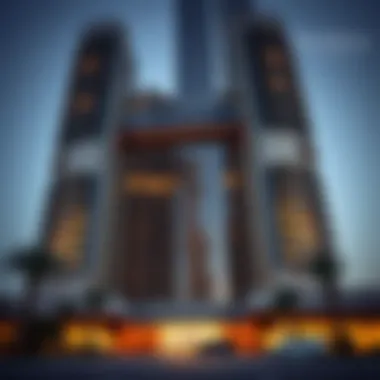
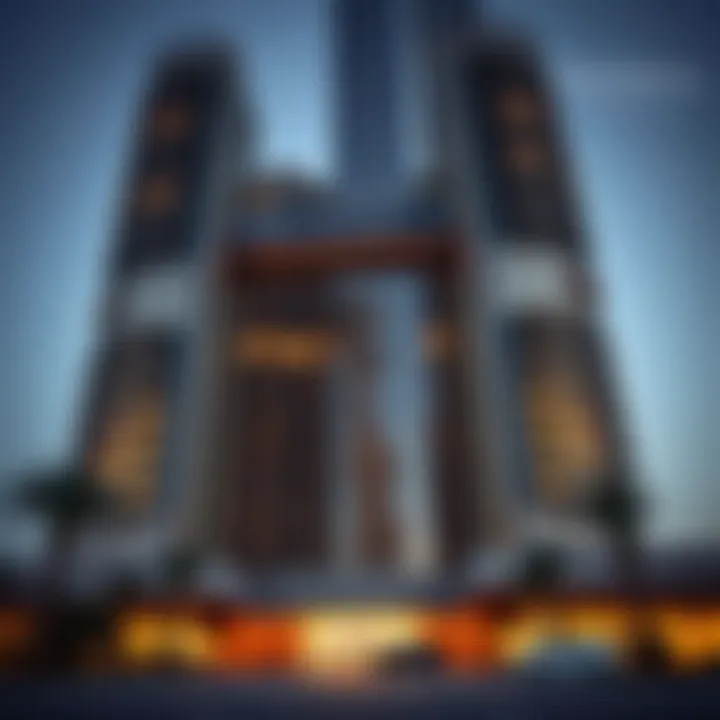
The impact of tall buildings on economic development cannot be overstated. In the UAE, skyscrapers have become synonymous with real estate development and economic growth. The substantial investment in such high-profile projects illustrates a strategic approach to attracting foreign investors and boosting tourism.
In comparison, cities like Dubai and Abu Dhabi manage to sustain interest through high-end amenities often housed within these towers, catering to affluent expatriates. The allure of luxury living and commercial spaces in skyscrapers like the Burj Al Arab elevates not only property values but also the cultural cachet of the city itself.
Considerations regarding return on investment are nuanced:
- Location and Demand: Skyscrapers in prime locations draw high demand, leading to significant capital increases. For instance, properties along Sheikh Zayed Road often rapidly appreciate, showing that location matters.
- Tourism Boost: High-rises attract visitors. The Burj Khalifa welcomes millions of tourists yearly, ensuring consistent economic flow through hospitality and commerce.
- Market Dynamics: Conversely, towering structures elsewhere might experience market saturation, as seen in some New York areas where overdevelopment has limited returns.
Future of Tall Buildings in the UAE
The landscape of the United Arab Emirates continues to evolve at a pace that electrifies both locals and foreign investors. The future of tall buildings in the UAE is not just a reflection of architectural ambition, but also a testimony to the relentless spirit of innovation that drives the nation. As urban environments expand and populations swell, the importance of these towering structures becomes ever more pronounced. They not only serve as symbols of wealth and progress but also as lifelines for burgeoning populations seeking modern amenities and quality living spaces.
Upcoming Projects
A flurry of new projects is on the horizon, promising to redefine the UAE's skyline once again. For instance, the Dubai Creek Tower, which aims to exceed the height of the Burj Khalifa, intends to bring a new level of architectural brilliance and engineering prowess. This building is designed to stand as a beacon, incorporating elements of traditional Islamic architecture and modern technology.
Moreover, the Meydan One Tower is in the pipeline—intended to be a mixed-use high-rise that combines residential, commercial, and hospitality offerings all in one. Such developments resonate with future demands for integrations of work and lifestyle, creating a holistic living experience.
- Investment Opportunities: With these upcoming projects, investors will discover a ripe ground for exploring new avenues in the real estate sector.
- Technological Innovations: The utilization of advanced building technologies, like prefabrication, will likely reduce construction time while ensuring safety.
Long-Term Urban Visions
Eyes aren’t just set on the next skyscraper, but also towards a sustainable urban future. City planners and architects are seriously focusing on long-term urban visions that transcend mere aesthetics. The shift towards greater sustainability involves designing buildings that produce energy rather than consume it, leading to a lower carbon footprint.
For instance, the development of Masdar City in Abu Dhabi serves as a pivotal model for future urban planning, emphasizing ecological sustainability and smart resource management.
"To think about future cities is to consider how they can better harmonize with nature while accommodating growing populations."
Key elements of these long-term visions include:
- Green Spaces: Integrating parks and recreational areas within the high-rise developments enhances residents' quality of life.
- Public Transport Solutions: With the increase in population densities, effective transport solutions become essential to connect dense urban neighborhoods.
- Community Engagement: Fostering a sense of community within skyscraper complexes helps mitigate the feelings of isolation that can come with high-density living.
As the UAE’s urban environment continues to develop, it is clear that the future does not simply rest on the height of buildings but also on their purpose within the fabric of society. The commitment to innovation and sustainability will guide the next wave of architectural achievements, ensuring that the skyline remains not only a marvel to behold but also a space where people can thrive.
Challenges in Skyscraper Development
The architecture of skyscrapers shapes not just the skyline but also influences urban dynamics. However, crafting these towering giants is far from a simple endeavor. Various challenges emerge, demanding foresight and adaptability, especially in a rapidly evolving landscape like that of the UAE.
Economic Fluctuations
Economic conditions play a pivotal role in the feasibility and success of skyscraper developments. Markets can be as unpredictable as a weather vane in a storm, dictating the financial viability of large-scale projects. For instance, during periods of economic downturn, funding might dry up like a desert spring, leading to delays or cancellations of projects.
Investors need to stay sharp, keeping an eye on not only local economic indicators but also global trends. Factors like oil prices can sway the real estate market in the UAE, which heavily relies on energy revenues. When oil prices plummet, so does the confidence in investments. Developers might be forced to reconsider the scale of their projects or find creative financing solutions to avoid losing their shirts.
Additionally, the fluctuations in currency can also pose complications for foreign investors. A strong local currency can make investments less attractive compared to when it is weaker. The need to mitigate risks associated with these economic variables adds another layer of complexity to the planning and execution of skyscraper projects.
"Investors must adapt strategies as swiftly as a chameleon changes colors in response to the environment."
Environmental Considerations
The rise of skyscrapers also brings along environmental challenges that cannot be overlooked. These towering structures often consume vast amounts of energy and resources during construction and operation. The UAE, with its extreme climate, poses unique hurdles. Eight months of sweltering heat, coupled with vast amounts of dust and sand, can strain materials and building techniques to their limits.
Designing for sustainability has become a priority for many developers. There's a growing realization that a skyscraper should not only reach for the heavens but also tread lightly on the earth. Incorporating green roofs, energy-efficient systems, and sustainable materials can minimize environmental impact while maximizing energy efficiency.
Water scarcity is another pressing issue. Implementing systems to reuse water or utilize innovative cooling techniques is crucial in order to combat this challenge. Drafting regulations that encourage or require environmentally friendly practices can elevate the initial costs but may lead to long-term savings and benefits.
Balancing the quest for height with environmental stewardship often feels like walking a tightrope. Developers must continually reevaluate their commitments and adapt to maintain not only the aesthetic but also the environmental integrity of their creations. In an age where green initiatives are no longer optional but necessary, skyscraper development faces the challenge of evolving alongside both economic and ecological needs.
Finale: The Significance of Skyscrapers in Shaping the UAE's Future
The skyscrapers in the UAE are more than just tall buildings; they are a reflection of a nation's ambitions, resilience, and modernization. As the tallest structures continue to rise, they symbolize the rapid growth of cities like Dubai and Abu Dhabi, showcasing the architectural prowess and engineering innovations of our time. The significance of these magnificent towers extends beyond their impressive heights, as they contribute to the economy, attract tourism, and define the identity of the UAE in a global context.
With each skyscraper, the UAE enhances its reputation as a business and tourism hub, drawing in investors from around the world. The integration of cutting-edge technology and eco-friendly practices in these buildings has ushered in an era of sustainable urban living, setting a benchmark for other nations to emulate. Indeed, these towering edifices are not mere landmarks. They serve as vital components within the urban ecosystem, offering residential spaces, commercial areas, and leisure facilities all under one roof.
In addition to their economic outcomes, skyscrapers play a pivotal role in shaping the skyline and the urban landscape. They provoke a shift in lifestyle dynamics, elevating the experience of living and working in such a breathtaking environment. Parks and public spaces, often developed alongside these structures, foster a sense of community, ensuring that human interaction remains a priority amidst urbanization.
As the UAE looks to the future, these architectural achievements will undoubtedly continue to influence urban planning and socioeconomic development. By investing in innovative designs and integrating sustainable strategies, the skyscrapers of the UAE are poised to lead the way toward a more sustainable and interconnected future.
Summarizing Key Takeaways
- Symbol of Progress: Skyscrapers are a testament to the UAE's innovative spirit and aspirations to become a leading global city.
- Economic Impact: These structures attract foreign investment, boost tourism, and create job opportunities in various sectors.
- Sustainability and Technology: The push for green architecture and smart building technologies in skyscraper design reflects a commitment to environmental stewardship.
- Urban Development: Tall buildings facilitate more efficient land use while enhancing public amenities like parks and community spaces.
Final Thoughts on Architectural Ambitions
The skyscraper phenomenon in the UAE underscores a broader narrative of ambition and determination. These soaring structures are not simply about height but rather about how they embody the culture of innovation that thrives in the UAE. They are a canvas where ambition meets progress, each telling its unique story while contributing to the collective identity of a nation that aims for the stars.
As new projects emerge on the horizon, it is crucial for stakeholders—from investors to urban planners—to continue prioritizing sustainability and community impact in their designs. This strategic approach ensures that the future of skyscrapers in the UAE not only serves as a continuing source of pride but also aligns with the needs and aspirations of its residents.
As we move forward, the skyscrapers of the UAE will surely inspire awe and admiration, solidifying their place not just in the skyline but in the hearts and minds of those who live, work, and visit this remarkable country.







